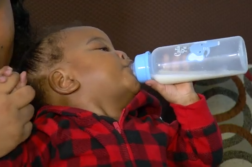SALT LAKE CITY, Utah. (Ivanhoe Newswire)— More than 50 years ago, a surgeon performed the first liver transplant. His first five patients died within five days. Today, 8,000 transplants are performed each year. The five-year survival rate is 75 percent. While the technique has improved, the way livers and other organs travel from donor to recipient hasn’t. Usually, they make the trip from hospital to hospital packed in a cooler filled with ice. Now, new technology is changing the transplant transport.
It’s often a race against time.
“We always have more patients that need organs than we have,” shared Diane Alonso, MD, FACS, Intermountain Healthcare program and surgical director of abdominal transplant services and liver, kidney, and pancreas transplant surgeon at Intermountain Medical Center.
Today, more than 15,000 people are waiting for a liver. On average, they’ll wait 239 days to get one, if they get one at all. Forty-eight-year-old Laura Adams was on that list, diagnosed with cancer in her liver.
“I had to do a certain amount of chemo, certain amount of radiation, before I was eligible for the liver transplant,” Adams recalled.
When asked if she would take part in a clinical trial to receive a new liver, she didn’t hesitate.
“What we have here is organ recovery systems’ liver pump,” described Jake Finnerty of DonorConnect.
The Intermountain transplant research team is one of the first to use a portable hypothermic machine to replace the traditional cooler. It keeps the organ working while outside the body.
“It’s kind of already revved up and ready to go,” illustrated Dr. Alonso.
The donated liver is connected to pumps that continually circulate a cold temperature, oxygenated, medical solution throughout the liver to keep cells alive and prevent clotting. The temperature is digitally monitored throughout transport.
“This gives us real-time data as to some of the changes that might be happening,” Finnerty explained.
This clinical trial is looking at whether the pump does two things …
“Do the patients get out of the hospital quicker? Do they have less complications post-transplant?” elaborated Jake Krong, research director at Intermountain Medical Center.
It may also allow less-healthy livers to be used for transplant.
“These organs were ones that we would not maybe even consider in the past,” said Dr. Alonso.
Laura received a liver that was Hepatitis C positive—the machine preserved the liver during transport, and after surgery, she took medication that cured the Hep C. New technology that may help save more organs and more lives.
Twenty-five hundred patients die every year before a donor liver becomes available. Transplanted organs most often come from deceased donors and less than 60 percent of adults in the U.S. are registered to be organ donors. As for this new technology, FDA approval is pending the results of this clinical trial. It could replace traditional coolers within the next few years.
Contributors to this news report include: Cyndy McGrath, Executive Producer; Marsha Lewis, Field Producer; Rusty Reed, Videographer; Roque Correa, Editor.
To receive a free weekly e-mail on Medical Breakthroughs from Ivanhoe, sign up at: http://www.ivanhoe.com/ftk
Sources:
https://www.healthline.com/health/liver-transplant-survival#purpose
MEDICAL BREAKTHROUGHS
RESEARCH SUMMARY
TOPIC: FORGET THE FREEZER: TRANSPLANT TRANSPORT GOES HI-TECH
REPORT: MB #4842
BACKGROUND: Organ transplantation is the surgical removal of a healthy organ from one person and then transplantation into another person whose organ has failed or was injured. It is considered major surgery that carries potential risks and drawbacks, the highest being organ rejection. There are nine types of organ transplants performed in the United States, according to the United Network for Organ Sharing in Virginia. In 2018, more than 36,500 organ transplants were performed, and most recipients were between the ages of 50 and 64. More donor organs come from deceased donors, but the percentage of living donors has increased since 1988. Organ transplants include kidney, pancreas, liver, heart, lung, and intestine, with kidney being the most common.
(Source: https://www.webmd.com/a-to-z-guides/organ-transplant-overview#1)
TRADITIONAL ORGAN TRANSPORTATION PROCESS: Once organs have been recovered timing becomes essential for the success of transplantation. Each organ is carefully preserved using special solutions and they’re packed on ice for transportation. Most organs travel to the hospital of the waiting recipient, escorted by the recovering surgeon and are then given to the surgeon who will perform the transplant. Some of the potential issues associated with this method of storage and transportation include variability of packaging materials used; bioincompatibility of the material that touches the organ; tissue injury due to movement or vibration; and potential uneven cooling of the organ tissue.
(Source: https://www.donoralliance.org/newsroom/donation-essentials/howorgansaretransportedfortransplant/?cli_action=1608729364.099 and https://www.ncbi.nlm.nih.gov/pmc/articles/PMC4593023/)
NEW TECHNOLOGY: A new technology, called portable hypothermic machine perfusion, circulates a specially formulated, cold-temperature medical solution throughout a donated liver inside a machine pump as it travels from the point of donation to the recipient for transplant surgery. This clinical trial seeks to determine whether machine perfusion improves overall outcomes for transplant recipients. Looking ahead, it is the hope that this may help transplant centers identify more viable livers for transplant and close the gap between supply and demand. “We hope to use this technology to increase the number of organs available for transplantation, while reducing complications and shortening the length of hospital stays,” said Diane Alonso, MD, program director of Intermountain Healthcare’s Abdominal Transplant Program.
FOR MORE INFORMATION ON THIS REPORT, PLEASE CONTACT:
ERIN GOFF
801-507-7455
If this story or any other Ivanhoe story has impacted your life or prompted you or someone you know to seek or change treatments, please let us know by contacting Marjorie Bekaert Thomas at mthomas@ivanhoe.com




